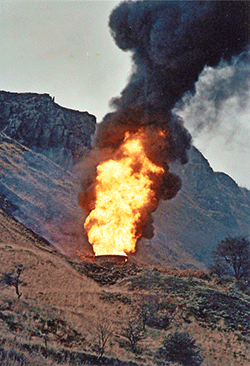At 1005 on December 20 1984, a major incident was declared by emergency services called out to tackle a fierce blaze deep within Summit Tunnel on the Calder Valley route between Manchester and Leeds.
The derailment of a freight train barely four hours earlier had resulted in the ignition of almost all its cargo of one million litres of petrol.
The fire would take four days to burn itself out as temperatures inside the bore rose well above 1,500 degrees Celsius - hot enough to melt brickwork, steel and weld tanker wagons to the rails. Above ground, assembled news crews, firefighters and local residents were confronted with the apocalyptic scene of 40m high pillars of flames escaping through ventilation shafts dotted about the rural Pennine hillside.
That the tunnel was repairable and could be re-opened just eight months later owed much to the containment efforts of the Greater Manchester and West Yorkshire fire services, but primarily it was to the lasting credit of the structure’s Victorian designers and builders, who toiled underground over 140 years earlier.
Opened on March 1 1841, the completion of Summit Tunnel overcame the final construction hurdle on the UK’s first trans-Pennine route: the Manchester & Leeds Railway. At 60 miles long, it was never going to be the shortest or quickest route between the two cities which are a mere 35 miles apart in a direct line, but the alignment was chosen to avoid steep inclines and use the existing tracks of the North Midland Railway from Normanton for the final ten miles into Leeds. Today’s northernmost trans-Pennine route to Leeds via Halifax and Bradford opened 13 years later in 1854.
Summit Tunnel is 15 miles north east of Manchester at the county boundary between Greater Manchester and West Yorkshire on a section of the line running roughly north to south between Littleborough and Walsden before the route turns to the east towards Hebden Bridge, Brighouse, Wakefield and Normanton Junction.
As its name suggests, the double-track tunnel is at the summit of the line with a rising gradient of 1-in-330 from Littleborough towards the tunnel’s northern portal, followed by a 1-in-182 falling gradient to Walsden. Cut through shale, gritstone, coal measures and broken ground, its brick lining varies in depth between five to ten rows throughout, with 14 ventilation shafts dug at intervals into the hillside above.
At 2,885 yards long, it was the longest railway tunnel in the world on completion but it would only hold this record until 1845 and the opening of the three mile-long Woodhead Tunnel linking Manchester and Sheffield.
The project’s famous chief engineer George Stephenson and his tunnel engineer Barnard Dickinson would face myriad geological challenges and difficulty penetrating the hard rock, driving the eventual cost to £251,000 – comfortably exceeding the tender price of £107,800 – and claiming the lives of 28 workers through accidents. Having laid the first brick in August 1838, the slow pace of construction would lead to change of contractors in March 1839 while labour disputes would result in 16 workers being brought before Magistrates in February 1841 for intimidating workmen in receipt of higher wages.
Delays to the tunnel forced the line to open in sections: Manchester to Littleborough in July 1839, Normanton to Walsden in December 1840 and the entire through route three months later.
When the last brick was laid in December 1840, Dickinson proudly boasted that the tunnel would defy “the rage of tempest, fire or war or wasting age”.
It was during that same month 144 years later that his words would be put to their sternest test in one of the most ferocious underground fires in transport history.
The train involved was the 0138 Haverton Hill (Teesside) to Glazebrook (Merseyside) freight train, consisting of 13 tank wagons containing 835 tonnes of petroleum hauled by Class 47 47125. Heading southwards, it entered Summit Tunnel at 0550 on December 20 1984 along the up line at 40mph. Three quarters of a mile inside the tunnel, the fourth and fifth wagons derailed, severing the air brake pipe and triggering an emergency application of the trains’ brakes.
The subsequent accident report compiled by HM Railway Inspectorate found the cause of the derailment to be a catastrophic failure of the fourth wagon’s leading left axlebox roller bearing. The damage caused to the track by the fractured wheelset caused all the following vehicles to derail and fire to break out quickly as leaking petrol was ignited by a hot axlebox.
Blocked by the spreading fire behind them, the train’s three-man crew ran the remaining mile to the tunnel’s south portal where they were able to advise a signaller at Preston Power Signal Box from a signal post telephone that the train was blocking both tracks, carrying petroleum products and that emergency services were required.
















Login to comment
Comments
Rich - 20/12/2021 11:24
Amazing story - worthy of a movie adaptation.
James - 30/12/2021 11:05
I notice no me.ntion if the tireless work by the Salvation Army to provide food and drink to all those involved on the West Yorkshire side of the tunnel. Greater Mancher FS had their own arrangements but West Yorkshire were often catered for by the Salvation Army.